 | 
| ||||||
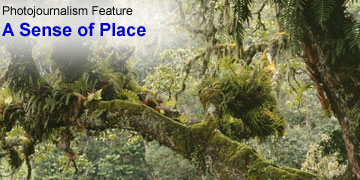 | Wildlife and landscape photography by Art Wolfe | |||||
 Bulbophyllum barbigerum  Megaclinium falcatum  Sobralia yauaperyensis  Coryanthes feildingii | When I unwrap a newly acquired plant and see the growth habit, my imagination runs wild. As one who doesn't travel much, each new orchid offers me a small window into its place of origin. We know that some orchid species are extremely localized. For example many Lepanthes are said to be restricted each to its own little stream valley. What is the landscape like in a plant's home? Is it found only in pristine forest or has it adapted to grow in disturbed forest now? How is the plant positioned in nature? Does it grow in the tops of trees in a cool cloud forest? Or does it cling for its life onto a barren rock face in a much harsher setting? Are those particular forests protected... or do they no longer exist? Are there still native people there, practicing their traditions? What are the ethno botanical relationships between the natives and the orchids... and what is the place of the orchids in local mythology? What are the conservation politics like in that country? What is the state of conservation politics in our own country? The alluring and night-fragrant orchid Plectrelminthus caudatus shares its West African home with the potto (Perodictus potto). The potto's slow, smooth movement makes them very hard to detect in the thick vegetation. To guard against predators, female pottos use a toxic glandular secretion to coat their young, while Mom goes out foraging overnight. As for the orchid, it grows in clearings nearly fully exposed to the sun and "is always found in areas that are described as 'warm to hot'". (Joyce Stewart, 1981) The forests of Gabon have exceptionally high levels of species richness and endemism. In 2002 Gabon's president, Omar Bongo, announced his government's decision to create a new national park system protecting some of the most critically important rain forest habitats. "Many important forest habitats in the country have been threatened by rapidly expanding logging operations as well as a growing commercial market for meat from wild animals, and conservationists have been working with Gabonese authorities to identify and survey areas that may deserve to be protected by law." (World Wildlife Fund 2001). Ever wonder about the lore of the Venezuelan Cattleyas? "Cattleya jenmanii - Late to the Party, Early to Leave?" an article by the Venezuelan orchid explorer G.C.K. Dunsterville, described rumors in 1958 of a beautiful new cattleya in southeastern Venezuela. When the new road south from Caracas to Brazil was completed in 1976 "a fine new hotel near Santa Elena decided to celebrate its opening with a grand display of Cattleya jenmanii, which some recently re-located Indians supplied by the truckload. The plants were planted in earth and a year later all had gone; dead or stolen - a tragic start for a fine species. Easy come, easy go!" (Dunsterville, 1979) Biologists have been fascinated by the Venezuelan Guayana, an area of richness and beauty, since the explorations of Humboldt and Bonpland and the Schomburgk brothers in the early 1800's. This is where there are 50 or so tabletop mountains, each known as a tepui. Each tepui holds the promise of unique plants. One, Cerro Autana, rises like a column from forests slightly above sea level straight up to 4000 ft. It is only 30 acres on top; man first set foot there in the early 70's - by helicopter. Dunsterville identified 7 different microclimates on the small summit -with about 30 different orchid species altogether. Canaima National Park is one of the few remaining places on Earth where 100% of the species are native. There are an incredible 10,000 vascular plant species in the Guayana. One of the world's most spectacular birds, Rupicola peruviana - the Andean Cock-of-the-Rock is distributed from Venezuela south to Bolivia. The Cock-of-the-Rock plays an important role in dispersing seeds of many different species of forest trees. Its courtship and mating behavior increases local plant diversity. The plant communities at the birds' nesting and mating sites differ greatly from the surrounding forest - with, in one case, 35 different trees and plants germinating from the birds' droppings. |  Aerangis biloba  Plectrelminthus caudatus  CATTLEYA jenmanii var. semi-alba | ||||
 Epidendrum criniferum |  Rupicola peruviana - (the Andean Cock-of-the-Rock) This spectacular bird plays an important role in dispersing the seeds of the forest trees. | 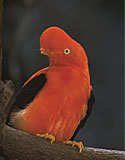 | ||||
| 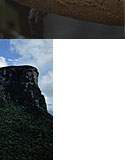 | |||||
 Dendrobium glomeratum  Dendrobium aberrans | Another spectacular bird is New Guinea's National Bird, the Bird of Paradise, Paradisaea raggiana - it's figure graces everything from stamps to taxis in that country. According to Conrad Gesner, the Swiss natural historian who first described the species in 1555 "it never sits upon the earth or any other thing, being born in Paradise." They were to always fly, never touching the ground. The female would lay her eggs on the males back, and hatch them as he flew. The relationship between man and the bird has been based almost entirely on trading the exotic and colorful plumes of the males for most of the history of civilization. In the 1800's there was a thriving trade in fashionable feather ornaments for ladies' hats and soon thousands of male birds were being exported from PNG. Groups like the Audobon Society, as well as local governments became concerned at the rate of decimation, and hunting of Birds of Paradise was banned in PNG in 1922. Maybe because only males were hunted, and the fact that males can impregnate many females, extinction was avoided. The biggest threat today is habitat destruction. "Discovered" by Europeans in 1528, New Guinea is the largest island in the world. Botanical exploration began in 1818. The first orchids reaching Europe included Dendrobium macrophyllum - sent by the French second officer of the 'La Coquille' in 1823. Rudolph Schlecter began his explorations of German New Guinea in 1981, eventually publishing his massive 'The Orchidaceae of German New Guinea'. It's Foreword by G. Hermon Slade emphasizes "Those of us who have walked over the terrain that Schlecter worked in, know that it is incredibly mountainous and difficult of access. One can ascend for hours a rocky steep slope only to reach a razor-back ridge that switches from what in Pidgin is called "bigfela goap-goap" to "bigfela godaun"; with not even a few square meters of space on which a tent or camp can be sited." In the quaint Schlecterian style the author wrote "According to the aspect of the mountains, we enter the sharply-defined mist forest at an altitude of 600 - 1000 meters... Here the orchid collector enters the true field of his activity, such indeed as regards richness of forms is not to be found elsewhere in the whole world." "What a glorious sight to suddenly find trees, the trunks of which are covered with the dark-purple flowered Dendrobium lawsii." Native villages had little or no inter-communication, particularly in the interior. Regional languages were so restricted and local that during a day's march into the interior, each village encountered had its own language. Orchid flowers are still used as adornments in headdresses and colorful bracelets are woven from tough orchid roots. Baby girls are wrapped in leaves of local orchids to ensure health, strength, and a capacity for drudgery, all qualities necessary to acquire a husband. Growing and conserving orchid species is a magical mystery tour - you have entered a multi-faceted, multi-dimensional world where you may discover as much about yourself as about the plants. Copyright 2005 All Rights Reserved. |  Dendrobium helix  Dendrobium laevifolium  Dendrobium macrophyllum 'ROCK' | ||||
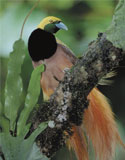 |  Bird of Paradise - (Paradisaea raggiana) The people of New Guinea adorn their ceremonial headresses with brightly colored Dendrobium flowers and Bird of Paradise feathers. They say the Bird of Paradise floats in heaven and feeds on dew. |  Dendrobium polysema | ||||
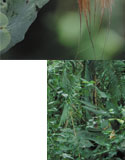 |
| |||||
Ordering Information Tropical Orchid Farm, Inc. • P.O. Box 170 • Haiku, Maui, HI 96708 • Toll Free (866) 572-8569 • Fax (808) 572-8917 © 2002-2024 Tropical Orchid Farm, Inc. All rights reserved. It is illegal to copy or otherwise distribute any of the content or photography on this site for personal, commercial or any other use. |